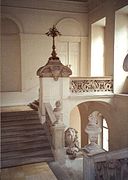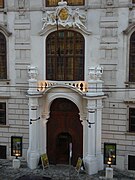Giovanni Battista Passerini
Giovanni Battista Passerini (* 1658 in Bohemia ; † 9. June 1710 in Kaisersteinbruch , Hungary, today Burgenland) was an Italian master stonemason and sculptor of the Baroque .


Live and act
His father of the same name and his colleague Francesco della Torre , who is a lifelong friendship, had once wandered from Ramponio in the province of Como , Italy, to the Wiener Bauhütte and the imperial quarry at Leithaberg , an Italian-Swiss artist colony , and learned the stonemasonry, in 1646 the Acquittal . In 1653 both masters worked as important collaborators in Carlo Lurago's Prague construction company . On October 30, 1663, they received the Prague Citizenship Certificate , as did Passerini's son and Torres' sons, Bartholomew, Pietro and Battista. With Lurago they worked on various construction sites, "but they really don't know how to name the Orth any more, be it at Komotau , Jesuit Church, with Count Czernin in Prague , with the Jesuits , in the Clementinum ..."
Giovanni Battista learned the trade while building the new Passau Cathedral , and his father died in 1678. As part of the Society, he designed the marble altar for the Elisabeth Chapel in the Wroclaw Cathedral in 1682 . Passerini left Bohemia in 1684.
In 1686 he bought three quarries, two houses and several gardens from Angela Regondi, widow of Ambrosius Regondi , and her son Sebastian Regondi in the imperial quarry . Then he asked for the hand of Anastasia, daughter of the current judge and master stonemason, Ambrosius Ferrethi .
His fellow master friend Giovanni Pietro della Torre had bought an estate here. When he was summoned to Prague in 1687, Passerini administered the property.
Lobkowitz Palace , Fischer von Erlach portal
In the tax list of 1699 Passerini was entered with a quarry, four houses and three cows.
Judicial office
In 1699 Passerini became a judge in Kaisersteinbruch . On August 29, 1707 he made a request to the abbot of the Heiligenkreuz Abbey, Gerhard Weixelberger , to resign from the judge's office; He said that in wartime he could no longer support the office that was due to me . In 1708/09 Master Sebastian Regondi Passerini was succeeded as judge.
student
In March 1700 he was responsible for training the journeyman Elias Hügel as a sculptor . During the renovation work on the Lobkowitz Palace in Vienna, Johann Bernhard Fischer von Erlach drafted the plan for a new type of portal design in Vienna and the entire order went to Passerini. This resulted in a decisive encounter with the famous architect for the young hill .
The masters of the Kaisersteinbruch stonemasonry
From 1699 to 1708 his co-masters were stonemasons and masons in Kaisersteinbruch : Johann Georg Haresleben , Ambrosius Hutter, Johann Baptist Kral , Johannes Pery , Sebastian Regondi, Johann Paul Schilck , Martin Trumler and Johann Wieser.
Prugg Castle in Bruck an der Leitha
From 1707 to 1711, Aloys Thomas Raimund von Harrach , Land Marshal in Lower Austria, had the older castle in Bruck an der Leitha rebuilt by the architect Johann Lucas von Hildebrandt . The artists who worked with Hildebrandt were the sculptors Johann Bendl, Giovanni Battista Passerini from the imperial quarry, Giovanni Stanetti , Joseph Kracker, the plasterers Alberto Camesina and Santino Bussi and the fresco painter Bartolomeo Altomonte .
death
Giovanni Battista Passerini died on June 9th, 1710, his property came in full to the widow Anastasia, who married Master Simon Sasslaber in 1712 . His name is carved on the scroll of the Kaisersteinbruch sundial pillar by the sculptor Alexandru Ciutureanu .
Works
- 1672: Passau Cathedral , architect Carlo Lurago
- 1682: Breslau Cathedral , marble altar
- 1689: Palais Harrach (Freyung) , architect Domenico Martinelli , with the Viennese co-master Veith Steinböck
- 1689: Liechtenstein Garden Palace in Roßau, architect Domenico Martinelli, part of the family
- 1691/1694: Liechtenstein City Palace , in the family clan
- 1702: City palace of Prince Eugen , western extension, architect Johann Lucas von Hildebrandt
- 1707: Prugg Castle in Bruck an der Leitha, architect Johann Lucas von Hildebrandt, main portal
- 1708: Bohemian court chancellery , with Haresleben , architect Joh. Bernhard Fischer v. Erlach
- 1709: Lobkowitz Palace in Vienna, new main portal, with Elias Hügel , plan by Joh. Bernhard Fischer von Erlach
literature
- Passerini, Giovanni Pattista . In: Hans Vollmer (Hrsg.): General lexicon of fine artists from antiquity to the present . Founded by Ulrich Thieme and Felix Becker . tape 26 : Olivier – Pieris . EA Seemann, Leipzig 1932, p. 277 .
- Otto E. Plettenbacher: History of the stonecutters of Vienna in the 17th century. An economic and cultural historical as well as sociological investigation. Price list from 1688, set order of the stone carvings. Dissertation University of Vienna 1960.
- Franco Cavarocchi: The Passau cathedral artists from the Intelvi valley. Passau 1980.
- Ludger Drost: The Passau Cathedral by Carlo Lurago. Unprinted master's thesis Passau 1992.
- Felix Czeike : Historical Lexicon Vienna. Volume 4. Vienna 1995.
- Herbert Haupt: The handicrafts exempted from court and court in baroque Vienna 1620 to 1770. (= research and contributions to the history of the city of Vienna, No. 46). Studien-Verlag, Innsbruck, Vienna, Bozen 2007, ISBN 978-3-7065-4342-2 .
- The masters Passerini and Sasslaber. No. 6, 1991, pp. 11-14.
- The Counts of Harrach Family Archives, Prugg Castle in Bruck an der Leitha. No. 36, 1995, pp. 24-30.
- Hometown Ramponio d´Intelvi, families Passerini and Torre. No. 47, 1997, pp. 13-64.
- Helmuth Furch : Historical Lexicon Kaisersteinbruch. Volume 2. Museum and cultural association, Kaisersteinbruch 2004, ISBN 978-3-9504555-8-8 ( ribera-philosophie.at PDF).
- Helmuth Furch: Brotherhood of the Kaisersteinbrucher stonemasons, enumeration 1650–1730. 2007, ISBN 978-3-9504555-4-0 .
- Carlo Agliati: Passerini, Giovanni Battista. In: Historical Lexicon of Switzerland . ( [1] As of December 1, 2009).
Web links
Individual evidence
- ^ Max Pfister, Bernard Anderes: Repertory of the Ticino artists. Switzerland's most forgotten cultural contribution to Europe. 2 volumes, 1994.
- ^ Vienna City and State Archives : Steinmetzakten, Brotherhood Book.
- ^ Prague City Archives: Prague Citizens Register.
- ^ Archives of the Diocese of Passau
- ^ Konstanty Kalinowski: Baroque in Silesia. Deutscher Kunstverlag, Munich 1990, ISBN 3-422-06047-2 .
- ^ Archives Mosonmagyaróvár , List of taxpayers in quarry 1699.
| personal data | |
|---|---|
| SURNAME | Passerini, Giovanni Battista |
| BRIEF DESCRIPTION | Italian master stonemason and baroque sculptor, judge in Kaisersteinbruch |
| DATE OF BIRTH | 1658 |
| PLACE OF BIRTH | Bohemia |
| DATE OF DEATH | June 9, 1710 |
| Place of death | Kaisersteinbruch |






